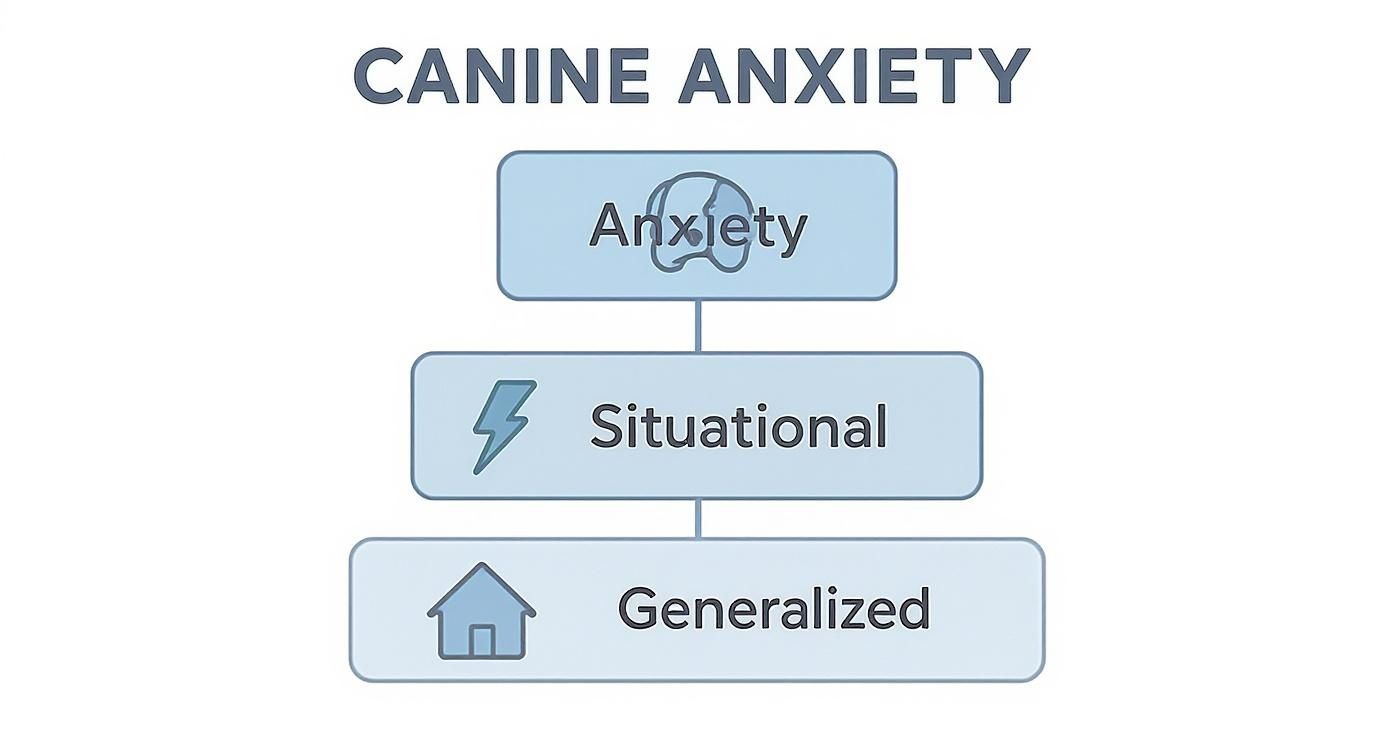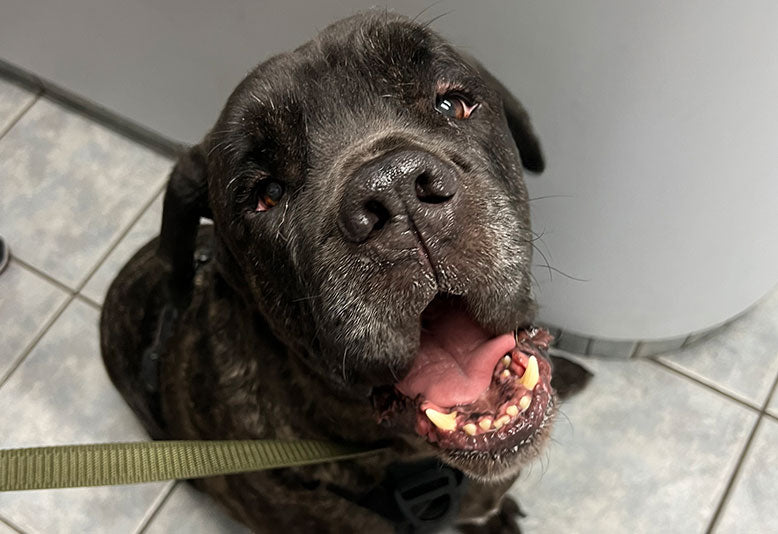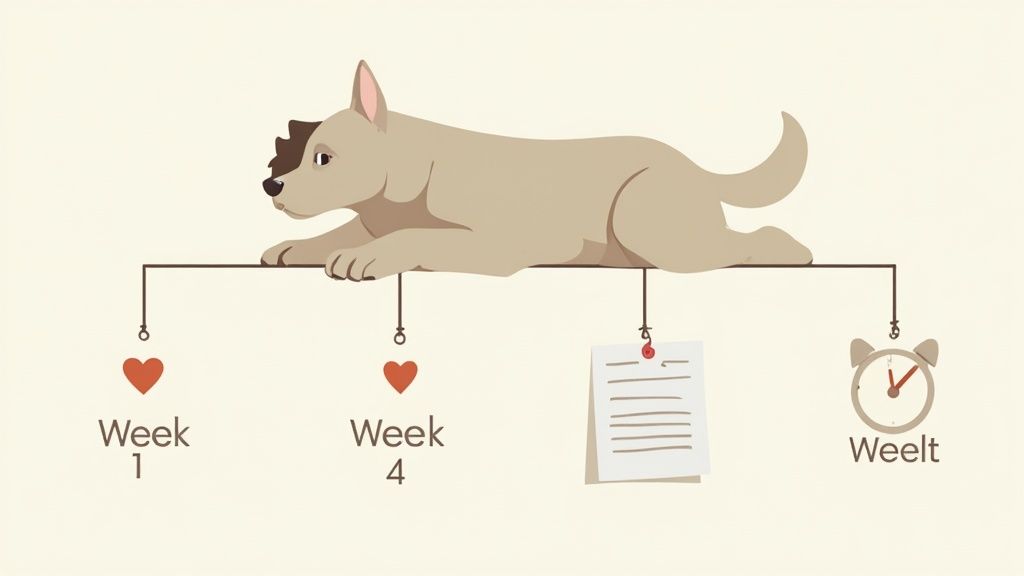
Medication for Canine Anxiety: A Guide to More Peaceful Days
It’s a feeling every loving dog owner dreads—watching your best friend tremble during a thunderstorm or hearing their panicked cries as you walk out the door. When they’re distressed, you feel it, too. This isn't just your dog acting out; it's a real cry for help. Looking for solutions, like medication for canine anxiety, is one of the most loving things you can do for them.
Recognizing When Your Dog Needs More Than Comfort
If you’ve found yourself doing those 3 AM searches, wondering why your once-fearless companion now paces the floors or hides at the first rumble of thunder, you are not alone. So many of us have been there. Those moments are heartbreaking—the frantic panting when you pick up your keys, the uncontrollable shaking during the Fourth of July. It’s completely natural to feel a deep need to bring their peace back.
This guide is for you, right in this moment of worry. We understand. The idea of medication can feel like a huge step, maybe even like you've failed somehow. Our goal is to gently walk you through the options, showing you that this is just another part of your journey together.
The Common Faces of Canine Anxiety
Anxiety in dogs isn't a one-size-fits-all problem. It shows up in different ways, some obvious and some much more subtle. Learning to spot the specific signs is the first real step toward finding the right kind of support.
- Separation Distress: This goes way beyond a sad puppy-dog face. We're talking about destructive chewing, non-stop barking, or having accidents in the house, but only when you're away.
- Noise Phobias: This is an intense, all-consuming fear of loud noises. Think thunderstorms, fireworks, or even the vacuum cleaner. Your dog might tremble, hide, or desperately try to escape.
- Situational Anxiety: For some dogs, the stress is tied to specific events. It could be the sheer terror of a car ride, a trip to the vet, or even the chaos of having new people in your home.
- Generalized Anxiety: This is a persistent state of worry that doesn’t seem to have a clear cause. A dog with generalized anxiety might always seem on edge, restless, and just can't seem to relax.
Sometimes, these behaviors can get tangled up with other health issues, especially as our dogs get older. For example, sudden new anxieties can be a sign of changes in brain health. It's often helpful to understand the signs of cognitive decline in senior dogs, as this can give your vet the full picture.
We see you. You’re doing your best for a dog that has given you their best. The most compassionate thing you can do is acknowledge that their anxiety is real and needs support.
From here on out, let's focus on progress. We’ll explore how different tools—from behavioral training and supplements to prescription medications—can create a safety net for your dog. The goal is simple: helping your best friend feel safe in their own skin again, so you can enjoy more good days together.
Get Your FREE Dog Brain Health Guide

Get instant FREE access to today's top ways to help your best friend live a longer, healthier, happier life.
- 39 value-packed pages of expert insights
- Early-detection tips for cognitive decline
- Top brain-boosting superfoods
- Vet-approved mental sharpness strategies
- Fun IQ tests for your dog
Understanding How Prescription Medications Can Help
If you've ever felt overwhelmed looking at veterinary prescriptions, you're not alone. It can feel like learning a new language. Our goal here isn't to turn you into a vet, but to give you the confidence to have a really productive conversation with yours. When you understand the "why" behind a treatment, you become the best possible advocate for your dog.
Let's be clear: using prescription medication for dog anxiety is a serious and well-established part of veterinary medicine. As more of us recognize when our dogs are struggling, the demand for effective support has grown. In fact, the market for ‘dog relaxants’—which includes everything from prescriptions to over-the-counter options—was valued at USD 186.2 million and is projected to hit USD 505.3 million by 2035. For dogs with deep-seated or severe anxiety, prescriptions are often a compassionate and effective path forward. You can discover more insights about the dog relaxants market on metatechinsights.com.
This infographic is a great starting point for seeing how different types of anxiety might call for different kinds of help.

As you can see, a dog’s anxiety can be triggered by specific events like a thunderstorm (situational) or be a more constant, simmering state of worry (generalized). This distinction is key, as it helps your vet map out the best journey for support.
To make sense of the options, it helps to group them by how they work. Here's a simple overview of the most common prescription medications your vet might discuss.
A Quick Look at Prescription Anxiety Medications
| Medication Type | Best For | How It Helps Your Dog |
|---|---|---|
| SSRIs (e.g., Fluoxetine) | Generalized, long-term anxiety | Slowly increases serotonin (a "feel-good" chemical) to establish a calmer baseline mood over several weeks. |
| TCAs (e.g., Clomipramine) | Separation anxiety, generalized worry | Works on serotonin and norepinephrine to rebalance brain chemistry for long-term emotional stability. |
| Benzodiazepines (e.g., Alprazolam) | Predictable, short-term panic (fireworks, vet visits) | Acts quickly on the central nervous system to provide rapid, short-lived relief from acute fear. |
| Other Situational Meds (e.g., Sileo®) | Specific fears, like noise phobia | Offers targeted, fast-acting calming for known triggers without causing heavy sedation. |
Now, let's unpack what these different approaches mean for your dog in the real world.
Building a Foundation for Calmness Over Time
For dogs who seem to live in a constant state of high alert, the goal is to gently support their brain chemistry over the long term. Think of it as building a new, more stable foundation for their emotional health. These medications don't offer a quick fix, but with consistency, they can create a meaningful shift.
-
Selective Serotonin Reuptake Inhibitors (SSRIs): You've probably heard of fluoxetine. SSRIs work by making more serotonin—a key "feel-good" chemical—available in the brain. Over several weeks, this helps lift your dog's mood and lower their baseline level of anxiety.
-
Tricyclic Antidepressants (TCAs): Clomipramine is a common TCA prescribed for dogs. It works in a similar way to SSRIs but also affects norepinephrine, another important chemical messenger. It's often a go-to for separation distress and other pervasive anxieties.
These medications are a commitment. They need to be given daily and usually take 4 to 6 weeks to show their full effect. It’s a journey of small, steady steps toward more good days.
Fast-Acting Support for Predictable Stress
Then there are the times you know your dog is going to struggle—the rumble of an approaching storm, the Fourth of July fireworks, or that dreaded trip to the vet. For these moments, you need a different kind of tool. Think of these medications as a fast-acting rescue for predictable, high-stress events.
You're not just giving a pill; you're offering your dog a safety net. This support can prevent a stressful event from becoming a traumatic one, helping them feel secure when their world feels scary.
These are typically given "as needed" a little while before the trigger occurs.
-
Benzodiazepines: Drugs like alprazolam work very quickly to calm the central nervous system, offering almost immediate relief from panic. Because their effects are short-lived, they're perfect for situational use but aren't meant for long-term daily management.
-
Other Situational Medications: We're seeing some great new options emerge, like Sileo® (dexmedetomidine), which is specifically for noise aversion. It’s a gel you apply to your dog's gums that calms them without heavy sedation, so they're still present but much less fearful.
How These Medications Create a Calmer Mind
It's really helpful to understand that these medications aren't "happy pills" designed to change your dog's personality. They work on a biological level to interrupt the physical cycle of fear and panic.
By adjusting the chemical messengers in the brain, they essentially turn down the "volume" on the anxiety response. This creates a state where your dog is actually able to learn new, calmer ways of behaving.
Medication opens a window of opportunity, making it possible for your dog to process that the world isn't as terrifying as it feels. This is exactly why it’s so powerful when paired with behavioral training—the medication provides the mental space for the training to stick. Every dog's journey is unique, and finding the right fit is a collaborative process with your vet, all focused on one simple goal: bringing peace back to your best friend's life.
Exploring Over-the-Counter and Natural Support
It’s completely understandable to want to try gentler options first when you see your dog struggling. The thought of putting them on a prescription medication is a big step, and most of us would rather start with something that feels more natural. If this is where you are, you're not alone in wanting to explore every possible way to bring your dog some comfort.
Over-the-counter (OTC) supplements and natural aids can be a fantastic part of a supportive care plan. Think of them less as a magic wand and more as a way to gently turn down the volume on your dog's stress. They often work best for milder anxiety or as a helping hand alongside a larger behavioral plan.
Gentle Support for a Worried Mind
Many of these supplements work by tapping into the body's own calming pathways. You'll often come across ingredients that encourage relaxation without the heavy-handed effects of some prescription drugs.
Here are a few of the most common and respected natural ingredients you’ll find:
- L-theanine: This amino acid, famously found in green tea, helps boost calming brain chemicals. The result is a feeling of relaxation without drowsiness—it’s like a quiet, reassuring whisper to an overactive nervous system.
- Tryptophan: As an essential amino acid, tryptophan is a key building block for serotonin, that "feel-good" chemical we talked about earlier. Supporting serotonin levels naturally is a great way to help stabilize mood and encourage a calmer outlook.
- Adaptogenic Herbs: Herbs like ashwagandha fall into a special category called adaptogens, which help the body become more resilient to stress. If you're curious about using these traditional herbs, you can learn more about how ashwagandha can be used for dogs in our detailed guide.
- Pheromones: Products like Adaptil are designed to mimic the calming pheromones a mother dog releases to comfort her puppies. They come in diffusers, sprays, and collars, creating a constant backdrop of security in your dog's environment.
The key with these ingredients is consistency. They work best when they're part of a daily routine, helping to build a stronger, more stable emotional foundation over time.
Supporting Brain Health for Mental Clarity
Helping a dog with anxiety isn't just about calming them down. It's also about supporting their overall brain health, especially as they get older. Anxious behaviors can sometimes stem from the confusion that comes with cognitive changes. Simply put, when a dog's mind is clearer, their world feels a lot less scary.
Science-backed ingredients can offer powerful support for cognitive function, which in turn helps with mental clarity and emotional balance.
Small improvements matter deeply. When your dog seems more present, more engaged, and less lost in their own home, it's a victory worth celebrating. That's the real goal of gentle, supportive care.
Supplements geared toward brain health usually contain a blend of ingredients that work together to support neural pathways and promote healthy brain function. This strategy isn’t just about tackling anxiety in the moment; it’s an investment in your dog’s long-term mental wellness. By supporting their cognitive health, you’re helping them navigate their world with more confidence.
Making an Informed Choice
Let's be honest: the supplement aisle can be overwhelming, and not all products are made with the same care. It is absolutely crucial to choose high-quality supplements from brands that are transparent and backed by science. Look for products made in FDA-registered facilities that are third-party tested for purity and potency.
And remember, even "natural" support should be discussed with your veterinarian. They can help you pick the right options for your dog's specific situation and make sure nothing will interfere with other health conditions or medications. Working together, you can create a complete plan that uses the best of everything—behavioral training, gentle support, and, if it comes to it, medication—to help your dog find their calm again.
Pairing Medication with Behavioral Training

Here's something crucial to understand right from the start: anxiety medication for dogs isn't a magic wand. It's a tool—a powerful one—that creates an opportunity for real change. It helps quiet the internal chaos just enough for your dog to actually hear you and be open to learning new, calmer ways of seeing the world.
Imagine your dog's anxiety is like a blaring alarm they can't turn off. They're so panicked they can't focus on anything else. Medication helps lower the volume on that alarm. The behavioral training you do in that newfound quiet is what truly teaches them to unlearn fear and build real, lasting confidence. The two work hand-in-hand.
Building Security Through Predictable Routines
For a dog struggling with anxiety, an unpredictable day is a scary day. One of the kindest, most effective things you can do is bring a gentle, predictable structure to their life. This isn't about military-style scheduling; it's about creating a rhythm that calms their nervous system and says, "Everything is okay. You are safe."
- Consistent Mealtimes: Feeding your dog at roughly the same time every day creates reliable, comforting anchors in their schedule.
- Scheduled Walks: Regular walks do more than just provide exercise. They offer a structured way to release pent-up nervous energy and engage their senses.
- Dedicated Playtime: Carving out specific time for positive, one-on-one interaction reinforces your bond and reassures them of their special place in your life.
This consistency builds a foundation of security. When your dog knows what to expect from their day, they can finally relax instead of constantly worrying about what might happen next. It's a simple change that can profoundly rebuild their sense of trust.
Creating a Safe Haven for Comfort
Every dog needs a spot that is 100% their own—a personal retreat where they can decompress when feeling overwhelmed. This should never be a place of punishment or isolation, but a cozy den they choose to go to.
You’re not just providing a comfy bed; you’re giving them a tool for self-soothing. This empowers your dog to manage their own feelings, which is a huge step toward building resilience.
To set up this safe haven, pick a quiet corner of your home. Fill it with their favorite soft blankets and maybe a special toy that's only for that spot. You can even add a pheromone diffuser or play some calming classical music nearby to make it extra inviting. Lure them in with high-value treats to help them build a rock-solid positive association with their peaceful sanctuary.
Using Mental Engagement to Build Confidence
Anxiety often festers when a dog’s mind is idle, leaving them to fixate on potential threats. A fantastic way to counteract this is by engaging their brain in positive, rewarding activities that build self-assurance.
Puzzle toys, snuffle mats, and treat-dispensing balls are brilliant for this. They challenge your dog to think and solve problems, giving their mind a healthy job to do. Every single time they figure out a puzzle and get their reward, it's a little win that boosts their confidence. It’s this cycle of thinking, problem-solving, and succeeding that teaches them they are capable and competent.
These aren't just training exercises; they are daily acts of love that help rewrite your dog's story from one of fear to one of quiet confidence. Each time your dog stays calm as you grab your keys or settles in their safe space during a storm, that's a victory. For a deeper look into these strategies, explore our guide to canine anxiety and behavior.

Support Your Dog's Brain Health with NeuroChew™
As mentioned in this article, NeuroChew is the first dog chew designed to support both cognitive function and healthy circulation. Perfect for dogs showing early signs of cognitive decline or for proactive brain health support.
How to Talk with Your Vet About Your Dog's Anxiety
Deciding to talk to your vet about your dog’s anxiety is a huge, loving first step. We know it can feel a little intimidating, but our goal here is to help you walk into that appointment feeling prepared and confident. You are your dog's best advocate, after all.
Remember, you're the world's leading expert on your own dog. The little details you notice every day—the stuff that makes you worry when the house is quiet—are exactly what your vet needs to hear. A little prep work ensures none of those crucial observations get lost in the shuffle.
Documenting What You See
Before you head to the clinic, try to keep a simple log of your dog's behaviors. Think of yourself as a detective gathering clues. When you can paint a clear, detailed picture, it helps your vet connect the dots much faster. A vague description like "he's just acting weird" is tough to work with, but specific examples are gold.
Try to jot down notes on these points:
- The Triggers: What seems to kick off the anxious behavior? Is it the rumble of thunder, the jingle of your car keys, or the doorbell ringing when a visitor arrives?
- The Behaviors: What does the anxiety actually look like? Get specific. Mention things like frantic pacing, hiding under the bed, a high-pitched whine that won't stop, or chewing on the doorframe.
- The Timing and Frequency: How often is this happening? Do the episodes last for a few minutes or stretch on for hours? Does the intensity seem to ramp up or down?
- Any Recent Changes: Think about what’s new in your dog's world. A recent move, a new baby or pet in the family, a change in your work schedule—even seemingly small shifts can have a major impact.
You're not alone in this. Your detailed observations are the bridge between your concern and your vet's clinical expertise. Together, you form the strongest possible team for your dog.
Key Questions to Ask During Your Appointment
Once you’ve shared what you’ve seen, the conversation shifts to a partnership. Having a few questions ready can help steer the discussion and make sure you leave with a clear plan, not more confusion. This is your chance to really understand the road ahead.
Here are a few essential questions to have in your back pocket:
- Based on what I’ve described, what do you suspect might be going on?
- What are all our options here, from behavioral training to medication for canine anxiety?
- If we do try a medication, what are the potential side effects I should keep an eye out for?
- Realistically, how long might it take before we start seeing some positive changes?
- How will we track progress? What small wins should I be looking for?
- Are there any natural, science-backed supplements that could complement this treatment plan?
This conversation is the starting point for helping your dog feel better. By showing up prepared, you give your vet the tools they need to give the best possible care. It’s a team effort, and taking this approach ensures you’re making informed decisions together to bring more calm, happy days back into your best friend's life.

Real Results: How NeuroChew Helped Brutus Regain His Mental Clarity
Brutus was getting disoriented at night. After starting NeuroChew, he's more happy during the day and steady at night. He's back to his old self!
A Safe and Patient Journey to a Calmer Dog

Starting your dog on a new medication for anxiety is a big step—one rooted in love and a deep commitment to their well-being. This process is a journey, one that requires patience, careful observation, and a close partnership with your veterinarian. You’re doing this to bring your dog some much-needed peace, so it’s important to remember that real progress often happens slowly and quietly.
We understand. The mix of hope and worry that comes with that first dose is completely normal. It’s natural to look for an immediate transformation, but many of the most effective long-term medications, like SSRIs, simply don't work that way. Think of it like watering a plant: you don't see the roots growing stronger underground, but that’s where the real work is happening. It often takes a good 4 to 6 weeks for these medications to build up in their system and establish a new, calmer baseline.
During this initial period, your role as your dog's advocate and observer is absolutely critical. The small wins—a full night's sleep without pacing, a flicker of interest in a toy, a relaxed sigh on the couch—these are the real signs you're heading in the right direction.
Monitoring Your Dog with Calm Confidence
Keeping an eye out for side effects can sound daunting, but it doesn't have to be a source of stress. When they do occur, most initial side effects are mild and fade as your dog’s body gets used to the new medication. You might see a bit of drowsiness or a temporary change in their appetite.
The trick is to observe, not panic. A simple journal where you jot down daily notes can be incredibly helpful. This log isn't just for you; it gives your vet a clear picture of what's happening at home and allows them to make informed adjustments if needed.
We measure success in peaceful nights and moments of recognition. It’s about more good days together, not finding a 'miracle cure.'
This is crucial: never adjust or stop a medication on your own. Suddenly changing a dose without your vet’s guidance can be risky and can set back the progress you've worked so hard for. Always lean on your veterinarian to navigate this process safely.
A Growing Commitment to Canine Wellbeing
Your dedication is part of a much larger, positive movement. More and more pet owners are recognizing the importance of their dogs' emotional health and seeking compassionate, effective solutions. In fact, the broader animal sedative market, which covers everything from surgical aids to behavioral medications like the one your dog may be on, was valued at USD 239.27 million and continues to grow. According to market analysis, treatments for behavioral and noise anxiety are the fastest-growing segment as owners strive to give their dogs stress-free lives. You can read more about these trends in the animal sedative market at mordorintelligence.com.
This journey to manage your dog’s anxiety is a profound expression of your bond. It's built on trust, patience, and the simple desire to see your best friend feel safe and happy. For those looking to complement their vet's plan with gentle, science-backed support, our NeuroChew™ supplements can help support cognitive function and promote mental clarity as part of a complete wellness routine.
Ultimately, this path deepens the incredible connection the two of you share. Every step you take is a testament to the promise you made to your dog: to give them your best, just as they give you theirs.
Common Questions About Canine Anxiety Medication
When you're trying to help an anxious dog, it's only natural to have a lot of questions. You want to do what's best for your best friend, and figuring out medication can feel overwhelming. Let’s walk through some of the things dog owners ask us most often.
How Long Does It Take for Anxiety Medication to Work?
That really depends on what kind of medication we're talking about. Think of it like this: some meds are for the sudden storms, and others are for changing the long-term emotional weather.
For those short-term, predictable events like fireworks or a vet visit, faster-acting medications can bring relief within an hour or two. They're designed for those specific moments of panic.
The daily medications, like SSRIs, play a longer game. They work by gradually helping to rebalance your dog's brain chemistry, which takes time. You’ll need to be patient here, as it can often take a full 4 to 6 weeks to see the real, lasting benefits. Don't get discouraged if you don't see a huge change overnight; you're building a new foundation for them.
What Are the Common Side Effects I Should Watch For?
The idea of side effects is always a little scary, but most of what you might see is mild and usually temporary. When a dog first starts a new medication, it’s not uncommon for them to be a bit sleepy or have a mildly upset stomach. Their appetite might even fluctuate a little.
This is typically just their body getting used to the new medication. Your job is to be their advocate and observer. Keep a close eye on them, and if anything worries you, don't hesitate to call your vet. They can tell you if it's a normal adjustment or if a simple tweak to the dose is all that's needed.
Can I Use Natural Supplements Instead of Prescription Medication?
This is a fantastic question, and it’s not always a simple "either/or" answer. High-quality, science-backed supplements can be an excellent part of the plan, especially for dogs with milder anxiety. Sometimes, anxiety is tangled up with other feelings; if your dog seems listless or down in addition to being anxious, it's worth taking a moment to understand the nuances of dog depression and how it all connects.
It's not about choosing between medication and a more natural route. The best strategies often blend multiple approaches: behavioral training, a supportive home environment, targeted supplements, and, when necessary, prescription medication.
For more severe anxiety, supplements often shine when used as part of a team effort, supporting behavioral work and even working alongside traditional medication. The most important step is to talk with your vet before starting any supplement to make sure it’s a safe and effective choice for your dog's specific needs.
At Furever Active, we understand this journey because we've been on it, too. Our goal is to support you with gentle education and natural supplements that help you give your dog more good days. Our NeuroChew™ supplements are crafted to support brain health and work hand-in-hand with the care plan from your veterinarian. Let us help you and your dog find more joy and peace in your days together. https://fureveractive.com
Share This Article

Support Your Dog's Brain Health with NeuroChew™
The first dog chew that supports both brain function and healthy circulation. Perfect for dogs of all ages.
- Enhances cognitive function & mental clarity
- Reduces anxiety without sedation
- Supports healthy blood circulation
- Made in USA with natural ingredients
60-Day Money-Back Guarantee • Free Shipping







